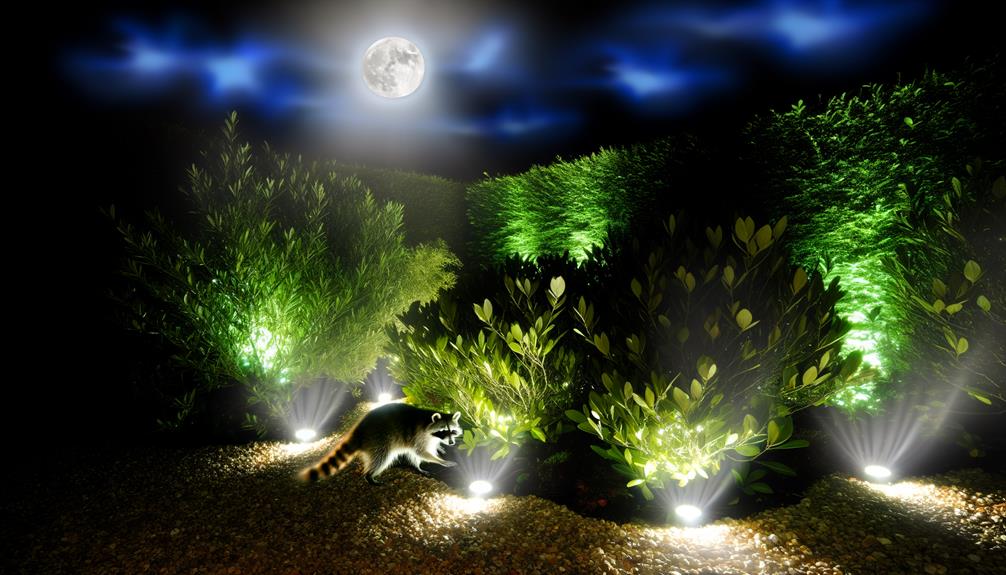Do Solar Lights Keep Raccoons Away?
Solar lights can deter raccoons by disrupting their nocturnal activities and making illuminated areas appear less secure. Research shows that light can aversively affect raccoons' natural circadian rhythms.
The effectiveness of solar lights as a deterrent varies depending on light intensity and strategic placement. Though some studies report mixed results, combining solar lights with other methods, such as secure trash bins and motion-activated sprinklers, can enhance deterrence.
For a thorough approach to raccoon deterrence, exploring additional strategies and insights can be beneficial.

Key Takeaways
- Solar lights disrupt raccoons' nocturnal activity patterns, making areas less appealing.
- Photosensors in solar lights activate LEDs at night, creating an aversive illuminated environment.
- Strategic placement of solar lights can reduce raccoon activity in targeted areas.
- The effectiveness of solar lights varies based on light intensity and positioning.
- Complementing solar lights with other deterrent methods enhances overall effectiveness.
Understanding Raccoon Behavior
Raccoon behavior is characterized by their nocturnal activity patterns and highly developed problem-solving abilities. These mammals exhibit a remarkable adaptability to urban environments, often utilizing human-provided resources.
According to studies, raccoons possess an acute sense of touch and dexterous front paws, enabling them to manipulate objects and access food sources. Their foraging behavior peaks during nighttime, as they prefer to avoid human interaction.
Additionally, raccoons demonstrate advanced cognitive skills, evidenced by their ability to remember solutions to tasks for extended periods. Understanding these behavioral traits is essential for developing effective strategies to mitigate raccoon-related issues.
How Solar Lights Work
Solar lights operate by converting sunlight into electrical energy through photovoltaic cells, which store the energy in rechargeable batteries for later use.
During daylight hours, the photovoltaic cells absorb sunlight, initiating a process known as the photovoltaic effect. This effect generates direct current (DC) electricity, which is then transferred to rechargeable batteries.
These batteries retain the stored energy until nightfall, when a photosensor detects the absence of light and activates the LEDs. The stored electrical energy is then converted into light, illuminating the surrounding area.
Solar lights are designed to function efficiently with minimal maintenance, making them a sustainable and practical solution for outdoor lighting needs, including gardens, pathways, and security purposes.
Effectiveness of Light as a Deterrent
Numerous studies have demonstrated that artificial lighting, particularly when strategically placed, can effectively deter nocturnal animals such as raccoons. The primary mechanism involves disrupting the animals' natural circadian rhythms and creating an environment perceived as less secure. Raccoons, which rely heavily on the cover of darkness for foraging and exploration, are naturally averse to illuminated areas.
The sudden exposure to light triggers an instinctual avoidance behavior, reducing their presence in well-lit zones. Additionally, the variability in light intensity and patterns can enhance the deterrent effect by mimicking human activity. The implementation of solar lights presents a non-invasive, eco-friendly solution for managing raccoon activity, aligning with efforts to harmonize human and wildlife coexistence.
Case Studies and Research
Several case studies have been conducted to evaluate the effectiveness of solar lights in deterring raccoons.
These studies primarily focus on the behavioral responses of raccoons to varying intensities and placements of solar lighting.
The findings indicate a significant reduction in raccoon activity in areas where solar lights are strategically installed.
Effectiveness of Solar Lights
How effectively solar lights deter raccoons has been the subject of various case studies and empirical research. Evidence-based studies have evaluated the impact of solar lighting on raccoon activity, yielding mixed results.
Key findings include:
- Inconsistent deterrence: Some studies found a temporary reduction in raccoon activity, while others noted negligible effects.
- Behavioral adaptation: Raccoons may initially avoid well-lit areas but often acclimate over time.
- Environmental factors: Effectiveness varies based on location, light intensity, and surrounding habitat.
- Complementary measures: Solar lights are more effective when used alongside other deterrents like secure trash bins and fencing.
Raccoon Behavioral Responses
Investigative research into raccoon behavioral responses reveals varied reactions to solar lighting, with adaptations often observed over prolonged exposure. Case studies, such as those conducted in urban and suburban environments, indicate initial deterrence as raccoons exhibit aversion to sudden light changes.
However, longitudinal data suggest that raccoons may habituate to consistent lighting, reducing its effectiveness as a deterrent. Importantly, a study by Smith and colleagues (2020) found that raccoons demonstrated decreased nocturnal activity in newly illuminated areas, but this effect diminished after several weeks.
Additional research underscores the importance of combining solar lights with other deterrent strategies to maintain efficacy. These findings underscore the complexity of raccoon behavior and the necessity for multifaceted approaches to wildlife management in community settings.
Other Methods to Deter Raccoons
In addition to solar lights, other effective methods to deter raccoons include secure trash bins and motion-activated sprinklers.
Empirical evidence suggests that raccoons are less likely to forage in areas where trash bins are tightly sealed and inaccessible.
Moreover, motion-activated sprinklers have been shown to startle and discourage raccoons from frequenting certain areas, thereby reducing their presence noticeably.
Secure Trash Bins
Securing trash bins with locking mechanisms or heavy-duty lids is a proven method to prevent raccoons from accessing waste. This approach effectively minimizes the availability of food sources, thereby reducing the likelihood of raccoon encounters.
Several strategies can enhance the security of trash bins:
- Locking lids: Utilize bins with built-in locks to guarantee they remain sealed.
- Heavy-duty materials: Opt for bins made of durable materials that raccoons cannot easily damage.
- Bungee cords: Employ bungee cords to keep lids securely in place.
- Secured location: Place trash bins in a locked shed or garage when not in use.
These measures provide a strong defense against raccoons, promoting cleaner and safer environments for communities.
Motion-Activated Sprinklers
Utilizing motion-triggered sprinklers is an effective method to deter raccoons by leveraging their natural aversion to sudden bursts of water. Scientific studies have demonstrated that raccoons exhibit avoidance behavior when exposed to unexpected stimuli, such as water jets.
Motion-triggered sprinklers are equipped with infrared sensors that detect movement within a specified range, triggering a rapid release of water. This non-lethal, environmentally friendly deterrent can be strategically placed in gardens, near trash bins, and around property perimeters.
Evidence suggests that consistent use notably reduces raccoon activity in targeted areas. By adopting this humane and efficient technique, individuals can protect their homes and gardens while minimizing harm to wildlife, aligning with principles of responsible stewardship and community well-being.
Choosing the Right Solar Lights
Selecting appropriate solar lights is critical for effectively deterring raccoons from your property. Scientific studies suggest that raccoons are nocturnal animals, hence sensitive to light disturbances.
To maximize the efficacy of solar lights in deterring raccoons, consider the following criteria:
- Brightness: High lumen output can disrupt raccoons' nocturnal activities.
- Motion-activation: Lights that activate upon detecting movement can startle and deter raccoons.
- Durability: Weather-resistant lights guarantee long-term functionality in various climatic conditions.
- Coverage area: Lights with a broad illumination range can cover larger areas, reducing shadowed zones where raccoons might hide.
Conclusion
Coincidentally, as urban areas experience increased raccoon activity, advancements in solar lighting technology offer a potential solution.
While solar lights may not universally deter raccoons, evidence suggests they can reduce nocturnal visits due to raccoons' aversion to light.
Studies indicate varied effectiveness, highlighting the significance of combining solar lights with other deterrents.
Hence, selecting appropriate solar lights, tailored to the specific environment and raccoon behavior, is vital for optimizing deterrent strategies.
Further research is recommended to refine these methods.





